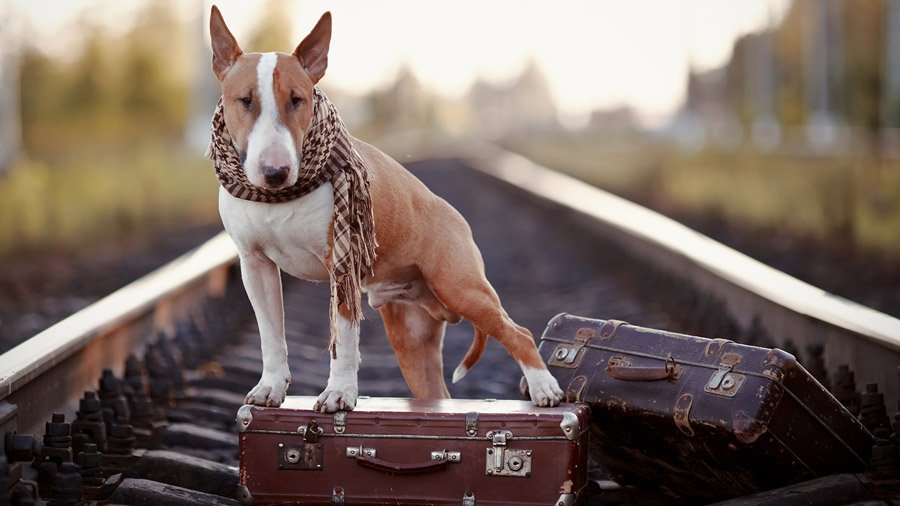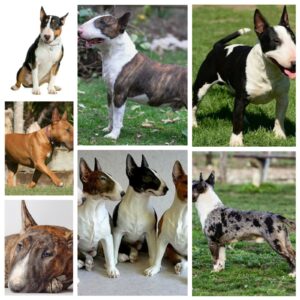
basic information
| Breed name: | bull terrier |
| Country of origin: | United Kingdom |
| The time of the birth of the breed: | 1862 |
| Type of: | terriers |
| The weight: | 25 - 36 kg |
| Height (height at the withers): | 44 - 51 cm |
| Life Expectancy: | 10 – 12 years old |
|
ICF classification:
|
Group 3, Section 3, Number 11 |
| Puppies price: | 250 – 1100 $ |
| Most popular nicknames: | list of nicknames for bull terrier |
Assessment of breed characteristics
| Adaptability
(a definition meaning how easily a dog can adapt to changes in life) |
🐶🐶🐶🐶 |
| Shedding level
(Level and frequency of hair loss in the animal) |
🐶🐶🐶 |
| Tenderness level
(The level and amount of tenderness and affection that the dog gives in return for attention to itself) |
🐶🐶🐶🐶 |
| Exercise needs
(Dog's daytime activity level) |
🐶🐶🐶🐶 |
| Social need
(The required number of contacts of the dog with other animals, as well as people) |
🐶🐶🐶🐶🐶 |
| Apartment content
(A factor that determines the level of noise and other inconveniences that a dog can deliver to owners in relation to the size of the apartment to the size of the dog) |
🐶🐶🐶 |
| Grooming
(The number of bathing, brushing, and the number of professional grooming sessions required for the dog) |
🐶 |
| Friendliness in an unfamiliar environment
(Features of the behavior of a dog in a society with strangers or in an unfamiliar environment) |
🐶🐶🐶🐶🐶 |
| Tendency to bark
(Tendency to bark and its frequency and volume) |
🐶🐶🐶🐶 |
| Health issues
(Potential health status of the dog) |
🐶🐶🐶🐶🐶 |
| Territoriality
(The dog's tendency to protect his home, yard, or even his owner's car) |
🐶🐶🐶🐶🐶 |
| Friendliness to cats
(The tendency towards tolerance for cats and decreased manifestation of hunting instincts) |
🐶🐶 |
| Intelligence
(The ability of the dog to think and solve emerging difficulties (not to be confused with learning!) |
🐶🐶🐶🐶 |
| Education and training
(The level of difficulty in training the dog to perform certain actions) |
🐶🐶 |
| Friendliness to children
(A factor that determines how friendly a dog is to children, whether he likes to play with them and tolerate some childish pranks) |
🐶🐶🐶 |
| Game activity
(The concept is determined by its very name, and, as a rule, is found in almost all dogs) |
🐶🐶🐶🐶🐶m |
| Observation
(The ability of a dog to detect the presence of a stranger on its territory) |
🐶🐶🐶🐶🐶 |
| Friendliness to other dogs
(The tendency of the dog to find common language with his other relatives) |
🐶🐶 |
Brief description of the breed
The Bull Terrier is a dog that is very attached to a person and tries to give all his attention and love to the owner. The main condition in the upbringing and training of the Bull Terrier is early socialization, otherwise the animal may show signs of aggression. Dogs This breed is suitable for families who lead an active lifestyle.
The Bull Terrier is difficult to confuse with other breeds. The specific shape of the head, the muscular body and the wayward character of the dog are its distinguishing features. This dog can be found in the paintings of various artists and in many commercials. This animal is full of energy, with a soft heart, immense love for children and devotion to the family. The pet loves to walk with the owner. He will always keep him company during jogging or just during active games.
Before you get this dog, you should be aware that there is a lot of false information about this wonderful breed. That is why it is important to know all the features of the Bull Terrier before making your choice in its favor. Knowing the characteristics of the breed will allow you to avoid disappointments and failures in education in the future.
The main advantages of this breed are: easy grooming due to weak manifestations of molting, cutting nails and caring for the ears as needed (on average 1 time in two weeks). Disadvantages of the breed: requires thorough washing after walking in rainy weather, as well as the need for constant stay with the family.
Bull Terrier color:
Origin story
The Bull Terrier was bred by crossing bulldog and terrier. The main purpose of the selection of this breed was to breed a dog with the strength and tenacity of a bulldog, and the attentiveness and dexterity of a terrier.
The first bred bull terriers were of different sizes. Some dogs were small. Their weight was 2-4 kilograms, they were classified as dwarf breeds. Others weighed 8 kilograms, and later dogs were bred, the weight of which began to reach 22-30 kilograms, that is, dogs close in size to the modern bull terrier. It should be noted that the selection of these animals was successful, because the breeders really managed to breed an animal with an amazing combination of the physiological characteristics of a bulldog and a terrier.
James Hinks, a famous nineteenth-century English bull terrier breeder, became the breeder who brought the breed to its present state. During breeding, he used white bulldogs and white English terriers, which today are considered an extinct breed. Thanks to his perseverance, he was able to get an amazing dog, which, having gained popularity in the 19th century, has retained it to this day.
Bull Terriers became a fashionable curiosity for urban men of the 19th century and have not lost their popularity over their century-old history of existence.
The popularity of the animal carried over to the United States. The American Kennel Club recognized the Bull Terrier as a separate breed at the beginning of the last century, when some breeders began to cross it with Staffordshire Terriers in order to breed dogs with different colors. Such crossings were crowned with success. The dog breeder managed to get a multi-colored bull terrier. The Multicolored Bull Terrier was recognized as a separate breed in 1936. To date, the Bull Terrier is ranked 53 among the registered breeds.
The character of the bull terrier
Maintenance and care
Caring for a bull terrier is very easy. To keep the coat in good condition, a weekly brushing is sufficient, which will be the key to a clean, shiny coat. The most active molt in these dogs occurs in spring and autumn, during this period it is necessary to comb the pet every day.
Bull Terriers do not require frequent bathing. Many owners of these dogs use dry shampoo or regular wet wipes. This, sometimes, is enough to keep the coat clean and prevent the occurrence of an unpleasant odor.
Bull Terrier like everyone else dogs, requires monitoring of the condition of the ears. This must be done every week. A special solution prescribed by a veterinarian is used as a means for treating the ears.
Weekly brushing will keep your teeth healthy and prevent bad breath. As for the nails, they need to be trimmed as needed.
Training and education
Bull Terriers are very smart. The learning process must begin at an early age. The lesson should take place in a calm environment, and their duration should not be very long, otherwise the dog will get tired of it all quickly, even if you use treats.
The education and training of these animals must be systematic, and the trainer will need perseverance and exactingness. Sometimes, even after successful training, bull terriers can be stubborn and simply refuse to follow commands. This kind of behavior should always be stopped.
If the family has small children, then the puppy should communicate with them from the first day of their appearance in the house. Bull Terriers are very fond of children, but sometimes they can show aggression towards other children, so the dog must be taught to communicate not only with his own, but also with other people's children. In this regard, early socialization is very important, which will be the key to raising a healthy and affectionate dog.
Health and disease
Some interesting facts
- Bull Terriers come in two colors: white and mixed color. At shows, they are presented according to color, but there is no gradation of the breed in terms of color.
- Looking at the Bull Terrier, you see in front of you a strong, muscular dog with an elongated oval head, something resembling an egg in shape. This is especially evident in dogs with a white color.
- Bull Terriers have small, upward pointing ears.
- One of the features of the breed is a short, but thick enough at the base, tail.
- Bull Terriers are real movie stars. They starred in hundreds of different films.
- Dogs of this breed are the only recognized owners of triangular eyes.
Nurseries and breeders
We borrowed material from the wonderful site of our partners DOGCATFAN.COM about cats and dogs, the author dogcatfan
Interesting profiles:
View this post on Instagram
View this post on Instagram
View this post on Instagram

